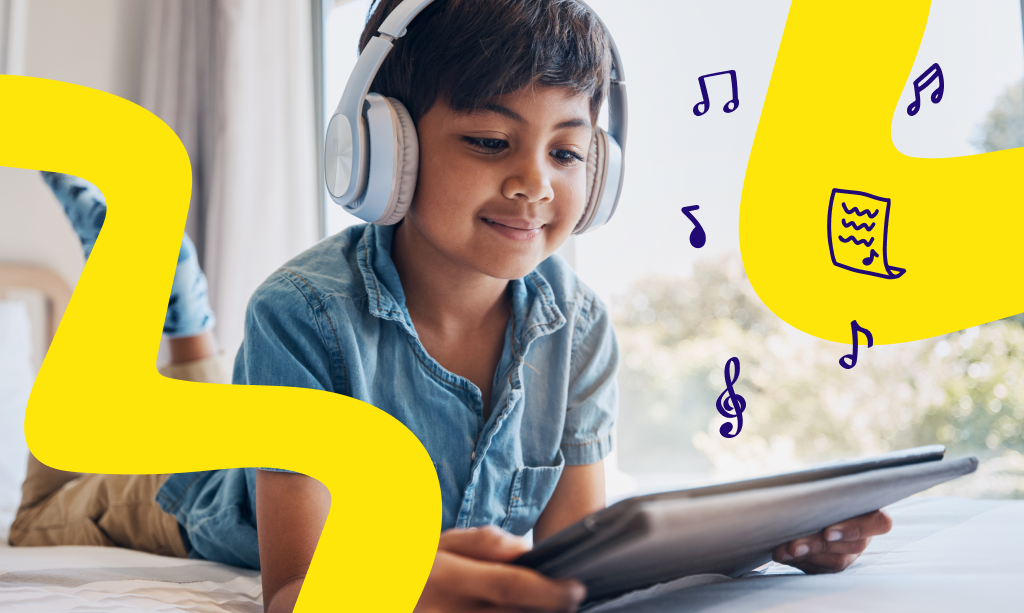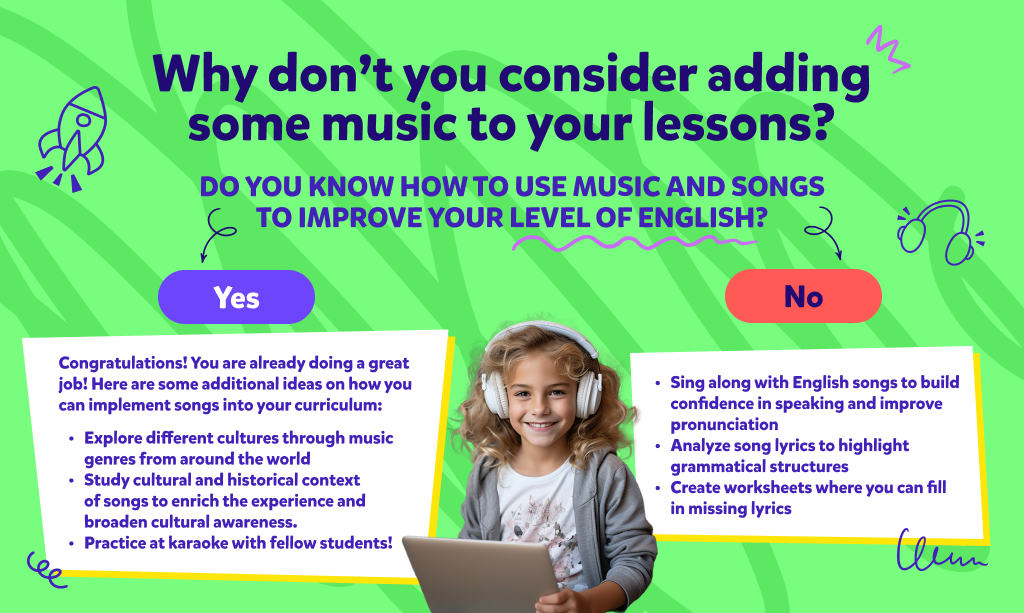Have you ever felt happy singing along to a song? What if singing could also help you learn English better? That’s what this article is about: using music and songs to make learning English more fun! We’ll explore how songs can help you remember words, say them right, and understand different cultures.

Music introduces a refreshing and enjoyable alternative to typical language learning practices. Each song is a little story that can help you learn English words and how to say them. Even if you hear the same words over and over, it’s not boring because you’re enjoying the music. Plus, when you sing along, it’s like practicing English without even trying!
But songs aren’t just about words; they also teach us about different places and people. Imagine hearing a song from a faraway country. Even if you don’t understand every word, you can still feel the music and learn something about where it’s from.
If you are anything like us at Novakid, you love music and incorporate it into your everyday life. Keep scrolling to explore how singing and listening to music can make learning English a great adventure and how you can practice your English without even trying, thanks to the help of a little tune.
Benefits of Using Music in ESL Learning
Using music to improve your English comes with many benefits that make learning enjoyable and effective. Whether you’re tapping your feet to a beat or belting out lyrics, incorporating music into your English learning journey is a great way to enhance your skills and have fun while doing it. Here’s why:
Improves Pronunciation: Singing along helps with correct pronunciation and intonation. This will help you practice speaking correctly.
Enhances Vocabulary: Exposure to new words and phrases in songs helps you build up your vocabulary bank with new words and phrases.
Boosts Memory: Music aids in better retention of language concepts, as the rhythmic and melodic elements make it easier to remember words and grammar structures.
Choosing the Right Songs
When it comes to integrating music into ESL learning, selecting suitable songs lays the foundation for a successful language-learning experience. Consider the following criteria when choosing songs:
Level-Appropriate: Pick songs that match your proficiency level, ensuring they are neither too easy nor too difficult to understand.
Clear Lyrics: Opt for songs with clear and easily understandable lyrics, facilitating comprehension and engagement.
Engaging Content: Select songs with interesting and culturally relevant content, which will help you motivate and connect to the material.
Incorporating Music into Lessons
The next step is to actually incorporate music into your English lessons. Talk to your tutor about using music to help with learning if they aren’t already doing this. Then, take what you learn in your lessons and replicate it at home. Here are some ways to do this:
Listening Activities: Use songs for listening comprehension exercises, providing you with exposure to natural spoken English in a musical context.
Fill-in-the-Blanks: Create worksheets where you can fill in missing lyrics, promoting active engagement with the language and reinforcing vocabulary and grammar.
Discussion and Analysis: Have discussions about themes, vocabulary, and grammar found in songs to help with critical thinking skills and a deeper understanding.
Singing Along and Karaoke
Another way to incorporate music into your life and help practice your English in a more enjoyable setting is to try karaoke! By incorporating musical activities, you not only enhance your language skills but also boost your confidence. Let’s explore how singing along and karaoke can enrich the ESL learning journey.
Sing-Along Sessions: Sing along with English songs to build confidence in speaking and improve pronunciation. This interactive activity allows you to practice speaking in a relaxed and enjoyable manner.
Karaoke Practice: Karaoke is a fun and interactive learning tool. You can sing along to English songs with lyrics displayed on the screen. This activity not only reinforces language skills but also creates a supportive and inclusive learning environment.
Using Music to Teach Grammar and Syntax
As you can already see, exploring music as a tool for ESL practice unveils a world of possibilities beyond conventional language learning methods. To dig even deeper into music, use it to help teach grammar and syntax. By integrating song lyrics into grammar lessons, educators can create learning experiences that resonate with learners and deepen their understanding of English grammar and syntax.
Here’s how to do this:
Identify Grammar Patterns: Analyze song lyrics to highlight grammatical structures such as verb tenses, prepositions, and sentence structures. By identifying these patterns, you can better understand how grammar functions in context.
Sentence Construction: Create sentences using phrases or lines from songs. This reinforces grammar rules and promotes creativity and language production. Additionally, it helps you understand how grammar is applied in real-life situations.
Cultural Learning through Music
Music not only makes learning English fun, but it also helps you to understand different cultures and ideas from around the world. Through music, you not only improve language skills but also gain insight into diverse cultures and traditions.
Introduce different cultures through music: By being exposed to a variety of music genres from around the world, you can gain a bigger appreciation and respect for global diversity.
Song Backgrounds: Delving into the cultural and historical context of songs allows you to understand the cultural significance behind the music, enriching the experience and broadening cultural awareness.
Creating a Playlist for ESL Learning
Finally, to take your English learning on the go and practice anytime you want to, create a specific playlist for learning ESL! Here’s an overview of how you can go about it:
Thematic Playlists: Organize your playlist based on themes or language topics. This can help you focus on specific vocabulary, grammar structures, or cultural aspects of English. For example, you could have playlists centered around:
- Daily routines and activities
- Love and relationships
- Travel and adventure
- Emotions and feelings
- Work and professions
- Nature and the Environment
Lastly, ensure that the playlist is easily accessible. You can create it on a streaming platform like Spotify or YouTube, or share a list of songs with links for easy access. Consider creating a collaborative playlist where different learners can contribute directly.
If you want to increase your skills even more, consider taking a trial lesson with Novakid to talk more in-depth about songs and music.
In summary, using music and songs for ESL practice makes learning fun and effective. It exposes you to real language use and engages you in various language skills. With themed playlists and learner input, music can allow you to have an enjoyable learning experience wherever you are!






































